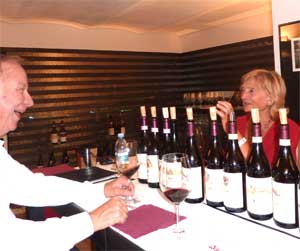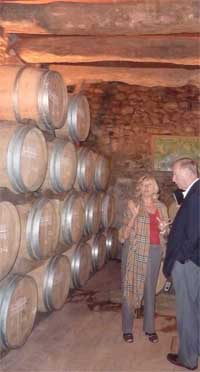Vietti Winery — A Family Jewel
© by Neil Duarte
On several occasions over the past few years, I have written reviews of a number of excellent wineries in the Barolo-rich Langhe Valley of Piedmont, Italy, some 50 or so miles southwest of the city of Turin. All of these wineries have been located in the town of Serralunga d'Alba. Today we venture forth a few miles to the west to the equally quaint town of Castiglione Falletto, another fortress hill town where wine reigns supreme.
Like most of the family vineyards and wineries in this area, the Vietti winery has been growing grapes and/or producing wine for approximately two hundred years. When it was founded as a family farm, it produced a number of various crops including grapes. However, in 1919 Patriarch Mario Vietti made the first Vietti wines and transformed the estate into a pure vineyard and winery.
The Vietti estate today, having regained property lost during the turmoil of the 1930s, owes much its current success to the efforts of Luciana Vietti Currado and her innovative winemaker husband, Alfredo Currado. They are joined today by their son, Luca, a veteran of wine making experience in Bourdeaux and California before returning to the Vietti estate, as well as son-in-law Mario Cordero, who handles marketing and sales and Luca's wife, Elena, who does the PR work.
A visit to the Vietti winery located in the town presents a challenge, as it is not well marked (it is directly behind the castle). Having finally located the entrance, we were greeted by Luciana herself, a most charming and gracious lady. Her tour, filled with interesting historical insights, was a true highlight in itself. We learned of and actually saw the tunnel that at one time connected the castle at Castiglione Falletto to the castle at Serralunga in the Middle Ages when sieges were a team sport in Piedmont. Luciana also showed and described to us the winemaking processes and extensive cellars.
Having completed a most enjoyable tour, we moved to the tasting room for the real test.
 | |
| At the tasting, Senora Currado explains each wine. Photo: Terry Duarte. |
Our first red was the DOC Dolcetto d'Alba Tre Vigne, a blend of three vineyards. I had tried this wine several years before and loved it, prompting this visit to the Vietti estate. This 100 percent Dolcetto has its alcoholic fermentation in stainless steel tanks and its malolactic fermentation in Slovenian oak barrels for six months. It is reddish purple in color, slightly fruity in nose and the typical Dolcetto soft finish. It is excellent with light meats and pasta.
Next we tried their five – yes five! – Barbera selections. Alfredo Currado was again one of the first in the area to offer single vineyard wines. Not wanting to miss anything, we tried all five. We began with the DOC Barbera d'Albo Tre Vigne, a blend from three separate Barbera vineyards. The wine is made from 30-35 year old vines with alcoholic fermentation of 10 days in stainless steel tanks at 26-28°C followed by malolactic fermentation in Slovenian oak barrels, French barriques and stainless steel tanks. Ruby purple in color, the wine had soft tannins (the oak) and a nice finish. This medium red wine would be an excellent choice for pasta or light meats.
Two other Barbera d'Albas from a single vineyard followed the blend. Scarrone from the vineyard of the same name is produced from 20 year old vines, given alcoholic fermentation in stainless steel tanks at 26-28°C for 10-12 days. Its malolactic fermentation occurs when it is placed in French oak barrels for 16 months followed by two months in stainless steel tanks prior to bottling. The wine is ruby purple in color, has an intense fruit and vanilla nose and a nice long finish. It is ideal for heavier meats, game and the like. The second single vineyard offering was Scarrone Vigna Vecchio, made from 85 year old vines. It featured cold maceration, alcoholic fermentation at 26-28°C for 10 days, six months in oak barrels and an additional 11 months ageing in oak casks. The product of this process is a ruby red wine with a nose featuring berries and tar and a very long and smooth finish. I bought a bottle of this to bring home.
 | |
| One of the cellars of Vietti. Photo: Terry Duarte. |
Moving into the more robust reds, the next wine was another of my favorites and normally a good value for your money, a Langhe Nebbolio. Vietti's offering was called Nebbiolo Perbacco. Produced from 35-year-old vines from Castiglione Falletto and Novello (vineyards are vinified and aged separately), the alcoholic fermentation is accomplished in stainless steel at 28-35°C. The molalactic fermentation is done in both stainless steel and barrels. It is then aged in barriques for 10 months and then moved to Slovenian oak casks for another 16 months. At this time the winemaker selects some casks for the Vietti Barolo Castigione while the others are used for Nebbiolo Perbacco. As I have said before, there is little difference between some Barolos and the Langhe Nebbiolos. Its color was the typical light ruby, and the wine was complex and smoky in the nose and solid in its finish. This was a very nice wine.
One of my reasons for selecting the Vietti winery was that it produced a Barbaresco. Vietti's DOC Barbaresco Masseria, a 100 percent nebbolio is produced from a single vineyard in Neive, a small town in the Barbaresco DOCG area, approximately 15 miles northeast of Castiglione Falletto. Sometimes referred to as the"queen" of Nebbiolo wines in deference to the"king", Barolo, Barbaresco does not command the same high price as Barolos. The Barbaresco Masseria was made from 40 year old vines, had its alcoholic fermentation accomplished in open stainless steel for 13 days at 30-32°C and after malolactic fermentation in barriques, it was transferred to Slovenian oak casks for a total of 24 months aging. It was a pale ruby in color, slightly fruity yet tannic and acidic with a rounded but long finish. I am a fan of Barbarescos wines especially with heavy meat dishes. Vietti is not a large producer of this wine, but, in my opinion, it is definitely a quality producer.
We moved on to the Barolos. Vietti produces four different DOCG Barolo wines and one Reserva, five of them from single vineyards. First we tasted the blend of grapes from four different areas, Castiglione. Made as described in the Nebbiolo Perbacco description, its appearance is the same but it was slightly smoother and longer in the finish. I liked it enough to buy a bottle to take home.
Since the rest of the Barolos are out of my normal price range the following table will highlight the differences between five absolutely fantastic Barolo wines. The alcoholic fermentation is between 14 and 18 days at temperatures between 28-34°C. All had very balanced tannins and the typical long Nebbiolo finish.
|
Name (Vineyard) |
Rocche |
Lazzarito |
Brunate |
Riserva Villero |
|
Vineyard Location |
Castiglione Falletto |
Serralunga d'Alba |
La Morra |
Castiglione Falletto |
|
Aging |
30 mo Slovenian Oak casks, 6 mo stainless steel |
12 mo French Oak barrels, 14 mo Slovenian Oak casks |
6 mo French Oak barrels, 18 mo Slovenian Oak casks |
6 mo French Oak barrels, 3 years Slovenian Oak casks |
|
Color |
Ruby Red |
Deep Garnet Red |
Intense Ruby Red |
Deep Ruby Red |
|
Nose |
Intense and Complex |
Intense and Aromatic |
Red Fruit and Unique |
Unique |
|
Alcohol % |
14.2 |
14.38 |
14.42 |
14.10 |
|
Bottles/ Year |
3245 |
5205 |
3938 |
Few Thousand only in Exceptional Years |
I found it impossible to say which was better, the Riserva excluded, because each was slightly different; but all were superb. My only comment is that if you can afford the best, these wine are definitely worth considering.
I will end by noting that the Vietti labels are truly unique and impressive. The Barolo Riserva"Villero" has a label created by a different artist specifically for that vintage and is really a collector's item.
Alfredo and Luciano have improved a great heritage in winemaking and left for their children one of Piedmont's finest wineries. It was a real pleasure for us to meet Luciana and Alfredo and to tour the Vietti Estate.
February 2010
